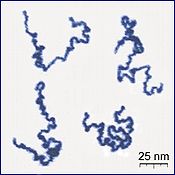Polymer
A polymer (Greek poly-, "mony" + -mer, "pairts") is a lairge molecule, or macromolecule, componed o mony repeatit subunits. Acause o thair braid range o properties,[2] baith synthetic an naitural polymers play essential an ubiquitous roles in iveryday life.[3] Polymers range frae fameeliar synthetic plastics sic as polystyrene tae naitural biopolymers sic as DNA an proteins that are fundamental tae biological structur an function. Polymers, baith naitural an synthetic, are creatit via polymerisation o mony smaw molecules, kent as monomers. Thair consequently lairge molecular mass relative tae smaw molecule compoonds produces unique pheesical properties, includin teuchness, viscoelasticity, an a tendency tae form glesses an semicreestalline structurs raither nor creestals.

The term "polymer" derives frae the auncient Greek wird πολύς (polus, meanin "mony, muckle") an μέρος (meros, meanin "pairts"), an refers tae a molecule that's structur is componed o multiple repeatin units, frae that oreeginates a chairactereestic o heich relative molecular mass an attendant properties.[4] The units componin polymers derive, actually or conceptually, frae molecules o law relative molecular mass.[5] The term wis made in 1833 bi Jöns Jacob Berzelius, tho wi a definition distinct frae the modren IUPAC defineetion.[6][7] The modren concept o polymers as covalently bondit macromolecular structurs wis proponed in 1920 bi Hermann Staudinger,[8] that spent the next decade findin experimental evidence for this hypothesis.[9]
Polymers are studied in the fields o biophysics an macromolecular science, an polymer science (that includes polymer chemistry an polymer pheesics). Historically, products arisin frae the linkage o repeatin units bi covalent chemical bonds hae been the primar focus o polymer science; emergin important auries o the science nou focus on non-covalent links. Polyisoprene o latex rubber is an example o a naitural/biological polymer, an the polystyrene o styrofoam is an emsaumple o a synthetic polymer. In biological contexts, essentially aw biological macromolecules—i.e., proteins (polyamides), nucleic acids (polynucleotides), an polysaccharides—are purely polymeric, or are componed in lairge pairt o polymeric components—e.g., isoprenylated/lipid-modified glycoproteins, whaur smaw lipidic molecules an oligosaccharide modifications occur on the polyamide backbane o the protein.[10]